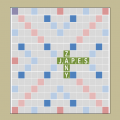| « Scrabble Card Box Guide (part 3) | Scrabble Card Box Guide (part 1) » |
Scrabble Card Box Guide (part 2)
Card Box Strategies
When beginning to study word lists for Scrabble, it's useful to know what to start with and how to create useful card box databases. There are many guides to what words to learn and most are useful, so you can choose one and adjust your study based on your performance. This includes one of those guides but before you dive in you may want to look at the philosophy behind what lists to include.
Objectives
When studying words for Scrabble, you should focus on the objectives of your study. Knowing why you are studying different word lists helps you to understand what lists you should add to your study plan, and in this case, to your card boxes. I see three objectives to word study, other than just learning words.
A. Make a play on the board
While it can be easy to make words on your rack, you have to find a place to play them. You can either use an existing letter on the board to make your play, or hook onto an existing letter or word. That's why you learn two and three letter words and hook words.
B. Make words and rack maintenance
Building an extensive vocabulary will help you find words using the tiles on your rack and the board. Your ability to play off undesirable tiles will also help with you next move. That's why you learn Vowel heavy words, the Q not U words, and words with duplicate undesirable letters.
C. Make big plays
Making high scoring plays is how you win games, so you should be able to capitalize on high point tiles, and bingo possibilities. That's why you learn seven and eight letter words (or bingos/bonuses), high fives, and words with JQXZ.
As you look at a study plan notice that these three objectives are often pretty clear. As you play, analyze your game success and focus on what you see as your biggest problem, making a play, making words, or making big plays. As you progress consider all three types in your word study plan. There are many study guides out there. You can choose one, but you should adjust your study based on your performance, goals, and whims.
Standard or List card boxes
Remember that in Hoot you can add words to either a standard (standard) card box like Anagrams, or to a List of Anagrams. The Anagrams card box stores new words as you add them and can get quite large. If you want to focus on a particular set of words you may want to use List boxes. Lists or list boxes are card boxes in Hoot built from a single search and you can create as many of these as you want. You give lists a title describing what they are. Lists are ideal for shorter lists that you can review quickly, but you may want to use them on other types of lists.
Longer lists
The standard card boxes are ideal for longer lists you want to study over an extended time. Use standard card boxes you may need to decide how many words at a time, in what order, and where to start at. Initially cards are presented in the order that you add them. When adding cards to a card box, think small. You probably don't want to add all seven letter words to begin with. If you do, you'll have to quiz yourself on those before any other cards show up.
You should also be careful about the order when adding large number of words to a list. Within a schedule and box number, words are shown in the order added to the box. While adding them in reverse probability order is often advised, understand that the most statistically probable are made up of vowels and one point consonants, so it will be a long time before you get to higher scoring words. It's my belief that you are more likely to draw a combination of low point and high point tiles. Sorting by reverse playability may be a good alternative.
Progressive Additions
When using standard card boxes remember that you can add and go through a list or words progressively. For example, you are not likely to want to study all four letters words at once. Instead you would be wise to add/study the most useful ones first.
For four letter words (5638) this is one way you might add them to your card box. Subsequent additions do not duplicate, so each addition builds on the previous one. They just add the words not already in the card box.
- Top Fours (273)
- JQXZ Fours (398, 125 more)
- High Fours (1920)
- Hookless Words (963)
- All Fours (5638)
Break down size of lists to suit your style. As you plan, notice the size of the list and decide if you want to learn them in a certain order. There are 133 vowel heavy words of length 2-5 letters, but 588 vowel heavy words of length 2-6 letters. You may want to learn the 6 letter words later. Also, while it is common to learn JQXZ words together, you could focus just on J words first.
Quiz types
There are three quiz types in Hoot, anagrams, hooks, and blank anagrams. Beginners should focus on both anagrams and hooks. Hooks are most useful when studying short words. As words get longer there are fewer hooks. Two letter words have 10-15 hook letters, while words longer than 5 letter usually have zero to one, and they are commonly S, R, or D. There are exceptions, of course. Over time anagramming will be your most important study type.
A blank anagram is where you add a blank to the current set of letters and anagram the new set of letters. Bingo stems are a type of blank anagram.
A Card Box Plan
Once you understand strategies for card box study you can select or develop your card box plan. This section just presents one such plan. Whether you use this plan or another, you should make adjustments to you plan when you discover some aspect of the game that you want to improve on, i.e. bingos/bonuses.
This plan has five levels. Within each level study the words in any order you prefer, but you should learn most of the words in each level before going to the next level. One way to determine your progress is to look at the stats for each quiz. Ideally you should have most of the words in Card box 3 before proceeding to the next level, that is, you've answered them correctly three times in a row. When words are added to a database remember that only new words are added.
Essential
- Two Letter Words
Basic
- Two letter hooks (or hooked threes)
- JQXZ 3-5 letter words
- Q not U 2-7 letter words
- V or C 3 letter words
Intermediate
- Top 3 six letter stems: RETAIN, SATIRE, TISANE (List Box)
- Vowel Dumps (3-5 letter words)
- Consonants (2-5 letter words)
Advancing
- Three Letter Words
- High Fives
- High Fours
- Three Letter Hooks (or Hooked fours)
- High Eights (???[JQXZ]*)|(????[JQXZ]*)
- I Dumps, U Dumps
- Ends in IER, IEST (5-8)
Advanced
- Four Letter Words
- Six letter stems
- Seven letter stems
- Sevens (100+ at a time)
- Eights (100+ at a time)
Plan modifications
As you study you may find other ways to create lists of useful words. An older piece of advice has been to learn all the seven letter words that can be formed from the letters STARLINE. I've advised using a variation of that by adding a blank: STARLINE? Other variations are RELATION?, NOTAIRE?, DEREGULATIONS.
Prioritize words by sorting differently. Sort descending by playability to learn words that have been considered the best play possible. Sort descending by score to learn high scoring words first. Sort descending by probability to learn words with high probability tiles.
Sequential additions
When studying long lists of words, it may be helpful to learn them 100 or 1000 at a time. You add these words like this. Decide on a search type and order, then set the Number of Words to 1000, and Starting With 1. After you've learned those you can add the next 1000, starting at 1001.
Other plans
Following are links to some other study plans
https://doubleblanks.wordpress.com/2010/08/18/a-study-plan-for-20102011/
http://www.sanjeev.net/scrabble-study-plan/index.html
https://www.thesprucecrafts.com/become-a-scrabble-champ-with-these-handy-word-lists-412409
https://www.quora.com/How-do-I-optimize-my-Scrabble-study-which-word-lists-are-the-most-important?share=1
https://scrabblestudyplan.blogspot.com/?m=1
Now that you have a plan you may want to know how to do searches for these word lists. That's what the next post is about.

